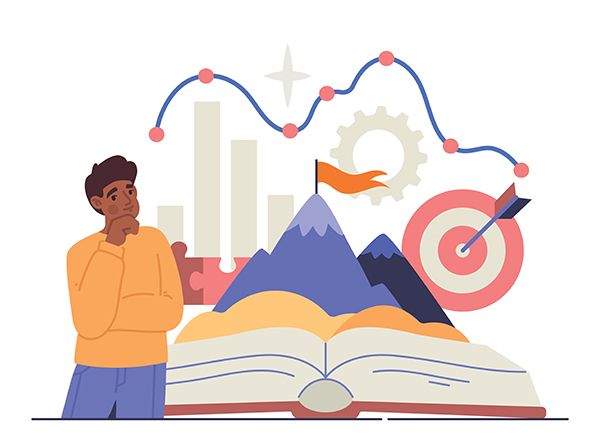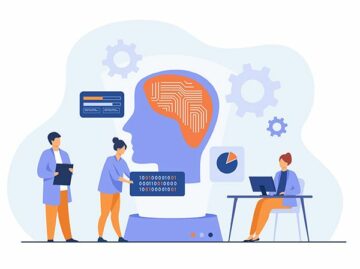

Businesses worldwide are churning out vast volumes of data like never before. Statistics show that people will generate 120 zettabytes of data by the end of 2023, and that number will likely climb to 181 zettabytes by 2025. To extract the full value of all this data, business leaders must prioritize data-driven practices such as data storytelling – a data management practice that helps everyone in an organization improve their data literacy. The goal: Build a strong data culture and gain a competitive edge.
What Is Data Culture?
While it may vary from organization to organization, data culture can be defined as the collective behaviors and beliefs of people who value, practice, and encourage using data to improve decision-making.
But why is a data culture important? At its core, data culture allows businesses to be more successful. It allows business leaders to make better use of available data in their activities that can be beneficial for the company. Most organizations keep stockpiling (read: “hoarding”) data, making data a liability in terms of storage, security, and compliance.
Too few executives realize the untapped potential of data and the insights that can be unlocked to drive better decision-making and eventual profitability. Historical data sets that go back decades could help unlock rich analytics for company sales, marketing, and supply chain forecasts.
According to research from Forrester, organizations that implement a data-driven approach are three times more likely to gain double-digit growth. But this is easier said than done: A report published by MIT Sloan School of Management found that adopting data culture is not a one-size-fits-all strategy but requires a customized approach dependent on the organization’s needs. Taking concrete steps toward building a data culture results in increased growth, profitability, and revenue.
The Power of Data Storytelling
Once a business has started collecting data, the next crucial step is to extract value from it. Data storytelling plays a huge role here. It helps organizations translate insights gained from data and communicate them to the right stakeholders, effectively and efficiently. Data storytelling is used to put data insights into context for the audience, whoever they may be, and to inspire action from them.
Data storytelling can take on multiple modes: visual, verbal, or written. The objective is to take complex ideas and convey them into digestible concepts. Observations and recommended actions can be integrated into the data storyline, making it easier for decision-makers to evaluate options and arrive at a conclusion. Use of narrative and contextual data can help the audience understand why a particular insight is important.
Visual elements, such as charts or graphs, further complement data storytelling. This helps highlight deviations in trends, outliers, and patterns that can help better translate the data. When combined with Data Science tools, narratives and visualizations can engage an audience and have a significant impact in determining actions and decisions.
For mature organizations, data storytelling is a crucial aspect of turning data insights into actions. It highlights important details that an audience might lose.
Storytelling has always been an effective mechanism for sharing ideas and having a lasting impact on the audience. Storytelling allows ideas to be memorable, persuasive, and engaging. One study documented how 63% of people could remember stories, while only 5% could remember a statistic.
Storytelling also helps increase the persuasiveness of an argument. When used to communicate insights from data, it can help drive sustainable and lasting change in an organization.
A notable example is of Hungarian doctor Ignaz Semmelweis, a mid-19th-century obstetrician, who discovered a stark difference in mortality rates between two clinics that observed different hygiene practices. Based on his study that spanned 18 months, Semmelweis introduced a handwashing policy that lowered the mortality rate by 82%. However, he was unable to communicate his findings effectively and faced extreme ridicule and opposition from the medical community.
Many significant insights suffer a similar fate if not properly communicated. Although the importance of uncovering insights cannot be disregarded, communicating them effectively and efficiently is just as important.
Barriers to Building a Data Culture
As obvious as the benefits might seem, the question may arise: What is stopping organizations from adopting a data culture?
There are several factors:
- Employee resistance: Longer-tenured employees as well as employees with a fixed mindset might resist the data culture.
- Resistance of stakeholders to cultural changes: As much as 91% of executives cite cultural obstacles as the biggest barrier to becoming data-driven. Executives must ensure the culture shift is gradual but systematic to succeed.
- The sheer amount of data: The vast volume of data available presents another challenge. Eighty to 90% of all data collected is unstructured, hence it is not easily gathered or quantified.
Considering these problems, data storytelling can work as a bridge and catalyst toward developing a data culture. Also, data storytelling advances data culture by lowering the barrier of entry for non-data-savvy personnel as well as helping build data literacy skills.
Steps to Creating a Data Culture with Data Storytelling
To become data-driven, business leaders must often invest in gathering, processing, and collecting data without the expectation of immediate return.
The hard truth is that organizations need to consciously create a game plan and take active efforts with a regular drumbeat to achieve their data culture goals. The following steps can be taken to get started:
Data collection and cataloging: Organizations must collect, sort, and organize data to get it ready for wrangling and drawing insights. Some companies opt to create a data lake that comprises both structured and unstructured data. While investing in such an enormous volume of data can be expensive, it will pay off in the long run. Once the data collection is done, it’s also important to keep a data catalog in order to be able to find the data quickly. The data catalog should list data attributes, handling information, and ownership details.
Find data evangelists within your organization: Organizations must identify data evangelists who will help lead and promote data culture and data storytelling in their respective domains. These evangelists can include executives who are passionate about data storytelling or employees who have fresh ideas to drive engagement. This must be followed by dedicated training to increase data literacy across the organization.
Employees should be able to work with tools and processes with sufficient prowess. Otherwise, the organization risks wasting their efforts in the long run. Depending on the need, a uniform or customized training plan should be deployed to coordinate and accelerate the upskilling.
Storytelling is one of the most efficient ways in increasing data literacy and reducing intimidation surrounding data in an organization. Storytelling helps key numbers to be translated into stories that could be related to organizational KPIs, thereby making data relatable and helping it come to life. Data should be democratized, accessible, and accurate to help break down data silos and provide updated, accurate data to process and work with. Teaching employees to use different data analysis tools such as Power BI and KNIME can help with the former objective and build a strong data culture.
Reward and role model: To promote a data culture, leaders need to model data storytelling and lead by example. When building strategies and working with teams, use data storytelling that explains what is happening and why. This will encourage and empower others to narrate their own data-based stories. Furthermore, organizations can incorporate data storytelling in organizational meetings, townhalls, and conferences.
To set precedent, leaders should opt for visual and interactive data-based storytelling instead of formal reports. Rewarding employees for adopting data-based storytelling can help create positive reinforcement. This catalyzes data culture and drives employees to use data-based storytelling positively.
Create a community of expertise (COE): Create a community of experts in the organization that serve as the North Star when it comes to developing a data culture.
The community can hold regular office hours to coach and mentor those with amateur data skills. The office hours will help create an informal, non-judgmental, and collaborative channel for people of all experience levels to come together and share ideas.
Special events such as meetups and offsites that are geared toward building data culture can also help foster a creative environment and drive the next S-curve in terms of data culture maturity.
Conclusion
Building a data culture has become of paramount importance to keep companies competitive and increase profitability. However, building a data culture is no easy feat. Leaders must navigate an array of obstacles and create effective strategies to succeed. Data storytelling can speed up this process and help build sustainable practices.
Image used under license from Shutterstock.com
- SEO Powered Content & PR Distribution. Get Amplified Today.
- PlatoData.Network Vertical Generative Ai. Empower Yourself. Access Here.
- PlatoAiStream. Web3 Intelligence. Knowledge Amplified. Access Here.
- PlatoESG. Automotive / EVs, Carbon, CleanTech, Energy, Environment, Solar, Waste Management. Access Here.
- BlockOffsets. Modernizing Environmental Offset Ownership. Access Here.
- Source: https://www.dataversity.net/building-a-data-culture-with-data-storytelling/
- :has
- :is
- :not
- $UP
- 2023
- 2025
- 224
- 300
- a
- Able
- About
- accelerate
- accessible
- accurate
- Achieve
- across
- Action
- actions
- active
- activities
- Adopting
- advances
- All
- allows
- also
- Although
- always
- amateur
- amount
- an
- analysis
- analytics
- and
- Another
- approach
- ARE
- argument
- arise
- Array
- AS
- aspect
- At
- attributes
- audience
- available
- back
- barrier
- based
- BE
- become
- becoming
- been
- before
- behaviors
- beliefs
- beneficial
- benefits
- Better
- between
- Biggest
- both
- Break
- BRIDGE
- build
- Building
- business
- businesses
- but
- by
- CAN
- cannot
- catalog
- Catalyst
- catalyzes
- chain
- challenge
- change
- Changes
- Channel
- Charts
- climb
- coach
- collaborative
- collect
- Collecting
- collection
- Collective
- come
- comes
- communicate
- communicating
- community
- Companies
- company
- competitive
- Complement
- complex
- compliance
- comprises
- concepts
- conclusion
- conferences
- context
- contextual
- coordinate
- Core
- could
- create
- Creating
- Creative
- crucial
- cultural
- Culture
- customized
- data
- data analysis
- Data Lake
- data management
- data science
- data sets
- data-driven
- DATAVERSITY
- decades
- Decision Making
- decision-makers
- decisions
- dedicated
- democratized
- dependent
- Depending
- deployed
- details
- determining
- developing
- difference
- different
- digestible
- discovered
- Doctor
- documented
- domains
- done
- down
- drawing
- drive
- drives
- easier
- easily
- easy
- Edge
- Effective
- effectively
- efficient
- efficiently
- efforts
- elements
- employees
- empower
- encourage
- end
- engage
- engagement
- engaging
- enormous
- ensure
- entry
- Environment
- evaluate
- events
- eventual
- everyone
- example
- executives
- expectation
- expensive
- experience
- expertise
- experts
- Explains
- extract
- extreme
- faced
- factors
- fate
- feat
- few
- Find
- findings
- fixed
- followed
- following
- For
- Forbes
- forecasts
- formal
- Former
- Forrester
- Foster
- found
- fresh
- from
- full
- further
- Furthermore
- Gain
- gained
- game
- gathered
- gathering
- geared
- get
- Go
- goal
- Goals
- gradual
- graphs
- Growth
- Handling
- Happening
- Hard
- Have
- having
- he
- help
- helping
- helps
- hence
- here
- Highlight
- highlights
- his
- historical
- hold
- HOURS
- How
- However
- HTTPS
- huge
- Hungarian
- ideas
- identify
- if
- immediate
- Impact
- implement
- importance
- important
- improve
- in
- include
- incorporate
- Increase
- increased
- increasing
- informal
- information
- insight
- insights
- inspire
- instead
- integrated
- interactive
- into
- introduced
- Invest
- investing
- IT
- ITS
- jpg
- just
- Keep
- Key
- lake
- lasting
- lead
- leaders
- levels
- liability
- License
- Life
- like
- likely
- List
- literacy
- Long
- lose
- lowered
- lowering
- make
- Making
- management
- Marketing
- mature
- maturity
- max-width
- May..
- mechanism
- medical
- meetings
- Meetups
- memorable
- might
- Mindset
- MIT
- model
- modes
- MongoDB
- months
- more
- most
- much
- multiple
- must
- NARRATIVE
- narratives
- Navigate
- Need
- needs
- never
- next
- no
- North
- number
- numbers
- objective
- observed
- obstacles
- obvious
- of
- off
- Office
- often
- on
- once
- ONE
- only
- opposition
- Options
- or
- order
- organization
- organizational
- organizations
- Others
- otherwise
- out
- own
- ownership
- Paramount
- particular
- passionate
- patterns
- Pay
- People
- Personnel
- plan
- plato
- Plato Data Intelligence
- PlatoData
- plays
- policy
- positive
- potential
- power
- Power BI
- practice
- practices
- Precedent
- presents
- problems
- process
- processes
- processing
- profitability
- promote
- properly
- provide
- prowess
- published
- put
- question
- quickly
- Rate
- Rates
- Read
- ready
- realize
- recommended
- reducing
- regular
- related
- remember
- Reports
- requires
- Resistance
- respective
- Results
- return
- revenue
- rewarding
- Rich
- right
- risks
- Role
- Run
- Said
- sales
- School
- Science
- security
- seem
- serve
- set
- Sets
- several
- Share
- sharing
- shift
- should
- show
- shutterstock
- significant
- silos
- similar
- skills
- Sloan
- some
- speed
- stakeholders
- Star
- stark
- started
- statistics
- Step
- Steps
- Stockpiling
- stopping
- storage
- Stories
- storytelling
- strategies
- Strategy
- strong
- structured
- Study
- succeed
- successful
- such
- sufficient
- supply
- supply chain
- Surrounding
- sustainable
- Tableau
- Take
- taken
- taking
- Teaching
- teams
- terms
- than
- that
- The
- their
- Them
- thereby
- These
- they
- this
- those
- three
- times
- to
- together
- tools
- toward
- Training
- translate
- translated
- Trends
- truth
- Turning
- two
- unable
- under
- understand
- unlock
- unlocked
- untapped
- updated
- upskilling
- use
- used
- using
- value
- Vast
- volume
- volumes
- was
- ways
- WELL
- What
- What is
- when
- while
- WHO
- whoever
- why
- will
- with
- within
- without
- Work
- working
- worldwide
- written
- Your
- zephyrnet












